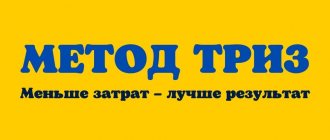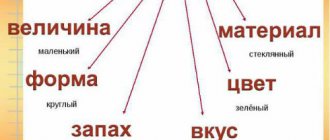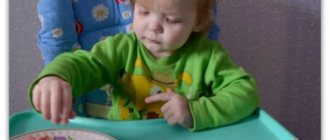What if the child answers “I don’t know”?
In fact, those who work using the TRIZ method are faced with a variety of situations, including childish stubbornness, reluctance to make contact, and getting involved in games using the TRIZ method. And we have already prepared recommendations for you on what to do in these cases [K. Nesyutina, 2014]. As a rule, such situations happen due to shortcomings on the part of adults. If desired, such situations are completely correctable, and over time, you can ensure that, upon hearing a question, the child begins to think about the answer, and not just remain silent or say “I don’t know.”
What to do to get your child to start thinking and reasoning:
- Never scold children for giving the wrong answer! Very often, “playing the silent game” is a consequence of the fact that the child has already said or done something wrong, received a bunch of comments, and is now simply afraid of making a mistake again.
- Reason with your child and don’t act like an examiner or a know-it-all. Children are acutely aware of falsehood, and if the child is already accustomed to the fact that you always know the correct answer and ask questions only for the purpose of testing, he may not want to be a test subject. Especially if, in case of an incorrect answer, he will also be scolded.
- Ask so-called “open” questions, for which there cannot initially be one single correct answer. This will make it easier for you to reason with your child, and the child will not be afraid to make mistakes. At the same time, he will understand that a different opinion is not necessarily wrong.
- Answer the questions your children ask you. Otherwise, children will quickly learn that they don’t have to answer or answer all “Whys” with “Because it ends in “y.” As a rule, children pick up such excuses from adults.
We wish that your children are healthy and happy, and that you always find a common language with them! We remind you that our program “TRIZ in practice: a creative approach at work and in life” and a screening test on the topic of the article are waiting for you:
We also recommend reading:
- Storytelling
- Creativity Development Digest
- Secrets of inventors: a selection of useful materials
- TRIZ classes for children: raising geniuses and simply happy people!
- TRIZ fairy tales in pedagogy
- A selection of useful materials about creativity and creativity development
- Charette procedure
- Invention: a selection of useful materials
- Good books for self-education
- TRIZ and design thinking in everyday life
- TRIZ, RTV and TRTL in practice: dealing with the Soviet intellectual past
Key words:1TRIZ
TRIZ methodology: implementation technologies
The essence of the TRIZ method for preschoolers is to draw the child’s attention to the features of the world around him, interesting phenomena and events, but at the same time not to give an exhaustive explanation and answer to all questions. In other words, you don’t need to give children ready-made recipes and solutions, you need to teach them to find answers on their own.
In this sense, TRIZ is quite rightly considered a “school of creative personality”, because TRIZ presupposes creativity in everything, from posing a question to ways of finding an answer. By the way, this is completely consistent with the concept of the great Russian teacher, psychologist and researcher Lev Vygotsky.
Thus, he explored the relationship between learning and development, thinking and speech, creativity and imagination, social environment and mental development. He introduced into scientific use the concept of the “zone of proximal development for children” and always insisted that learning is not the same as development. You can read more about his developments in this direction, in particular, in the book “Thinking and Speech” [L. Vygotsky, 1999].
Actually, the difference between TRIZ and traditional methods of working with children is precisely to give children the opportunity to think of things that are accessible to them with their own minds, and not just repeat what adults have said. Of course, such methods require special training on the part of preschool teachers.
At a minimum, they themselves should be able to see the unusual in the ordinary, the new in the familiar. And they must be able to show this new and unusual to children. How? For this purpose, there are special methods and technologies adapted to the characteristics of preschool age.
TRIZ methods for preschoolers are described in detail in the book “TRIZ Classes in Kindergarten (a manual for teachers of preschool institutions)” [P. Gin, 2010]. Options for applying these methods in practice can be found in the book “Development of Creative Thinking. Along the steps of TRIZ. First stage. Workbook" [E. Pchelkina, 2019].
Let’s say right away that in TRIZ methods for children we will see a lot in common with methods for stimulating creative activity and imagination in adults. The difference will only be in the specifics of the tasks that children face. All tasks are adapted taking into account the age and perception of preschoolers, and the teacher acts as a moderator of the discussion. So let's see how it works!
Brainstorming method
The brainstorming technique is that children are given a problem and asked to find a solution, and they are allowed to put forward any, even the most unrealistic, versions of the solution. Any criticism of the ideas put forward is prohibited, both from adults and from group mates in the kindergarten. You can only complement and offer improvements to other people's ideas. Tasks for brainstorming are chosen from among those understandable to children:
- How to save your grandmother from a gray wolf.
- How to put out a fire without water.
- Where to hide from the heat in summer.
When a lot of ideas accumulate, the discussion participants all together choose the best option.
Method of morphological analysis
The essence of the method is to try to combine different characteristics of an object when creating a new object. Let's say, if you need to invent a new game, for clarity, two axes are drawn. Along one they draw the parts of the body that will be involved in the game (arms, legs, arms + legs), and along the other are the playing devices that can be used (ball, tennis racket, jump rope).
Next, the whole team goes through possible options for combining and using body parts and gaming devices in the game, and at the end, you can invite everyone to play together a new game that the children have just come up with. Such games using the TRIZ method greatly develop fantasy, imagination, and the ability to interact. This is a simple example, but in principle, using the method of morphological analysis, you can invent much more complex things and find dozens of variations of a future invention.
Focal object method
This method assumes, to some extent, the opposite situation: you need to transfer the properties of one object to another. The simplest example: imagine and draw what a dog with wings, a bird with horns, or a waterfowling camel might look like.
In a similar way, you can try to “create” a hybrid of a ship and an airplane, a train and a submarine, a car and a helicopter. The main thing is not to limit children's imagination in anything! In this regard, the focal object method is ideal specifically for children, because its application possibilities are limited for complex technical solutions.
Directory method
The essence of the method is to arrange events in a logical sequence and come up with connections and transitions between them. In this way, for example, you can compose a new fairy tale. The teacher gives hints in the form of pictures and leading questions:
- Who is our main character in the fairy tale?
- Is this hero positive or negative?
- Why is this hero positive or negative?
- What bad did the bad guy do?
- What good did the positive hero do?
- How did they fight each other?
- Who supported the negative hero?
- Who supported the positive hero?
- How did the confrontation between good and evil end?
In addition to imagination, this TRIZ technique is useful in developing coherent speech, public speaking skills and expanding vocabulary.
Personal analogy method
As part of this method, children are asked to personally depict any animal, phenomenon, or object. You should start with simple tasks. Let's say, depict a cat or a dog, show how the cat or dog is angry, happy, asking for food.
Afterwards you can move on to more difficult tasks. For example, depict rain, a thunderstorm, snowfall, a storm at sea, a boiling kettle, or a working vacuum cleaner. Then you can further complicate the task. For example, ask the children to imagine how a cat or dog would sing the song “A Christmas Tree Was Born in the Forest.” Or choose a suitable song for the “singing vacuum cleaner”.
Little People Modeling Method
The little people technique in TRIZ is a simplified and accessible for children version of the structure of the surrounding world from three types of little people: “hydratics”, “tverdikov”, “pneumatics”. Solid objects seem to be made of “tverdik”, and the “tverdik” stand close to each other and hold hands tightly.
By analogy, liquids seem to consist of “hydratics”, because “hydratics” do not hold hands and can move relative to each other. But “pneumatics” are constantly in motion, so we cannot see air, gas and other gaseous substances with our own eyes.
To begin with, children are explained the structure of solid, liquid and gaseous objects separately, and only then in connection and interaction. For example, iced tea is in a solid cup made of “hards”, and itself consists of “hydrates”. If the tea is hot, steam from the “pneumatics” rises above it.
In a similar way, it can be explained why you can easily remove a spoon from a cup of tea by picking it up, but you cannot pick up water from a cup. If we imagine that a spoon consists of several “tverdiki” that hold hands tightly, then, by taking and lifting one “tverdik”, we lift all the others with it. And water consists of many “hydratics” that do not hold hands. Therefore, taking one “hydratic”, we can only pull it out of the cup, that is, only a drop of water.
Methodology of typical fantasy techniques
The method of standard fantasy techniques (TFT) involves changing the properties of an object using magic. The Wizard of Increase, the Wizard of Decrease, the Wizards of Division and Union, and also the Wizards who can take us to the past or future come to the aid of children.
Children need to imagine what will happen if this or that object is enlarged, reduced, divided into parts, or transferred to another era. Examples of practical tasks can be found in the report “Methodology of typical fantasy techniques (TPF)”, made specifically for teachers working with young children [L. Mikhailina, 2016]. By the way, this technique is suitable not only for kindergartens. This TRIZ technique is also used in elementary schools.
Goldfish method
The Goldfish Method consists of dividing a situation into its component elements, evaluating the elements as real or fantastic, and finding a rationale for elements that seem impossible and fantastic. This method was named according to the plot of a well-known fairy tale, and it is easiest to consider the application of the method using the example of a fairy tale about a goldfish.
Children are offered a line-by-line analysis of the work with a rating on the “real - fantastic” scale. So, the first few lines look quite real. The old man could really live with his old woman on the seashore, and indeed, instead of fish, with a net you can pull out both algae and mud. Fantasy begins from the moment when a goldfish falls into the net.
Can a fish be gold? Here the children are invited to find an explanation for this phenomenon. For example, fish scales sparkled in the rays of the sun and therefore seemed golden. Or the sea was distant and southern, where fish of the most bizarre colors are found. This is how children find reasons for phenomena that are incomprehensible and unreal at first glance. Therefore, the “Goldfish” method is often called the method of substantiating new ideas.
Snowball method
The Snowball method is the exact opposite of the Goldfish method. It is based on the assumption of a certain fantastic situation, on which, like a rolling snowball, very real events are layered. A classic use of this technique is the story “Amphibian Man” by Alexander Belyaev.
The initially unrealistic fantastic idea that gills were implanted into a person to breathe under water is superimposed on other, very real events from people’s lives. By the way, the “Snowball” method is most often used for writing fairy tales. And, using this method, it is quite possible to teach children to compose fairy tales on their own.
These are the most basic and most popular TRIZ techniques for preschoolers. You will find more methodological developments in the article “Conducting classes using TRIZ technology in kindergarten” [N. Fominykh, 2017].
We already foresee that some readers are ready to begin making skeptical remarks about the authors of the methodology and assumptions that the authors themselves did not work in kindergarten and have never seen living children. And they don’t know that even the most inquisitive and good-natured baby can in the blink of an eye turn into an angry, withdrawn creature who will answer all the adults’ questions by remaining silent or answering with a monosyllabic “I don’t know.” What to do in this case?



